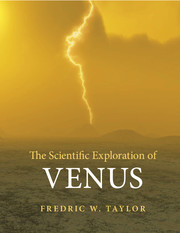Book contents
- Frontmatter
- Contents
- Overview
- Prologue
- A note on scientific units
- Acknowledgements
- Part I Views of Venus, from the beginning to the present day
- Part II The motivation to continue the quest
- Part III Plans and visions for the future
- Epilogue
- References and acknowledgements
- Appendix A Chronology of space missions to Venus
- Appendix B Data about Venus
- Index
- Plate section
Epilogue
Published online by Cambridge University Press: 05 September 2014
- Frontmatter
- Contents
- Overview
- Prologue
- A note on scientific units
- Acknowledgements
- Part I Views of Venus, from the beginning to the present day
- Part II The motivation to continue the quest
- Part III Plans and visions for the future
- Epilogue
- References and acknowledgements
- Appendix A Chronology of space missions to Venus
- Appendix B Data about Venus
- Index
- Plate section
Summary
Setting aside the Sun and the Moon, Venus is the brightest and the prettiest object in the sky. It is the closest planet, and the most Earthlike in size and structure. It has a thick atmosphere, and a serious case of greenhouse warming that resembles in many details the process threatening to cause serious global change on Earth. The surface has mountains, rivers and seabeds, but no water. The atmosphere contains familiar gases, nitrogen, carbon dioxide, water vapour.
As humankind gets more and more technically proficient, we explore Venus in greater detail and we learn much about our origins and the history of the Solar System that we inhabit. We will fly to Venus in person eventually, first to fly around the planet and return, then to orbit, and then to float in the Earthlike conditions near the cloud tops. Wemay even descend to the surface, in bathysphere-type craft with some advanced system of thermal control and a strong hull. Finally, we may become so godlike that we restore Venus to its earlier, more Earthlike state and move in there. There is nowhere else that seriously offers that possibility, not even Mars, until we reach the stars and their planets.
- Type
- Chapter
- Information
- The Scientific Exploration of Venus , pp. 277 - 278Publisher: Cambridge University PressPrint publication year: 2014
- 1
- Cited by



